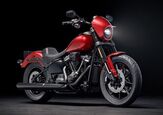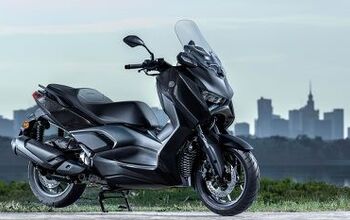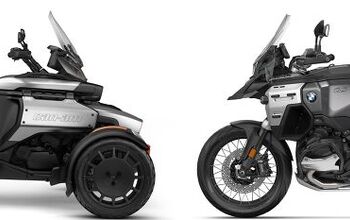How Many Miles Can a Motorcycle Last?
Motorcycles these days are built for the long haul, but how many miles will your average motorcycle last?
One of motorcycling's great debates is mileage, or rather how many miles a motorcycle can last. The short answer to that question is a decidedly anticlimactic: it depends. The truth is, this is a hotly debated subject among motorcyclists simply because it depends on numerous factors that influence the practical lifespan of any machine. Aspects such as maintenance practices, ownership habits, engine configuration, and riding environments all play essential roles in whether the odometer keeps clicking off the miles or not.
Chances are, if you landed on this page, you're searching for a new-to-you used motorcycle and wondering about its total mileage. This might be your first bike purchase, and if that's the case, congrats! We strongly encourage you to check out Motorcycle.com 's New Rider Series, hosted by our very own Road Test Editor, Troy Siahaan. If you're more of a more seasoned rider and looking to educate yourself on how much mileage is too much for a motorcycle, then we're going to cover a handful of helpful points when approaching the subject.
Maintenance Matters More Than Mileage
Maintenance is, by far, the single most crucial factor in a long and healthy lifespan for a motorcycle. Think about it: Our motorcycle owner's manual carefully and precisely dictates when all aspects of maintenance should be performed, from basic stuff like chain maintenance to more critical jobs such as oil changes, filter cleaning/replacements, valve adjustments, suspension refreshes, and even complete engine rebuilds (that's more of an MX/Enduro thing). These maintenance schedules aren't merely suggestive; they are steadfast rules developed by engineers through countless hours of internal testing to ensure your bike runs at peak potential, regardless of mileage.
In theory, the answer to "How many miles can a motorcycle last?" is "indefinitely," as long as proper maintenance is done at the prescribed intervals. Well-maintained high-mileage motorcycles can and often will last well past the 100,000-mileage marker, having numerous worn items replaced as part of routine maintenance. Imagine a two-wheeled Ship of Thesus, if you will, my fellow MOrons. Still, it is a concern that isn't entirely warranted because, according to the Federal Highway Administration, motorcycles in the United States travel an average of 2,484 miles annually. 15, 20, or 30k for your average street bike isn't much when viewed through the lens of a modern engine, and those numbers reflect what other markets almost expect a used motorcycle to have.
Finding examples of excellently cared-for used motorcycles with a documented history of manufacturer-recommended service intervals can alleviate much worry. After all, if an engine is being maintained with high-quality oil and fluids with the owner inspecting and serving components, as cited in the manual, then many of our mileage concerns are stopped in their tracks.
So, where do mileage stigmas stem from? Well, deferred maintenance fears are often cited concerning mileage, which is why many riders emphasize it—no one wants to buy someone else's problems or pay for costly services that the prior owner didn't get done. What "higher" mileage does impact is perceived value within the marketplace, especially for late-model bikes. A more significant concern for buyers should be whether parts can be procured, which is an issue with obscure or vintage motorcycles.
Engine Configuration and Use
When we're considering things like engine configuration and its riding history, mileage can become a question. What we're thinking about here is context.
Let's say you're looking at a dual-sport like the longstanding Honda XR650L motorcycle, powered by a single-cylinder engine with roughly 50,000 miles on it. That's an impressive figure for a thumper, especially considering how much work that single piston performed to get there. Yet, we can take that exact mileage figure and apply it to a touring motorcycle like the Honda Gold Wing, with its relatively low-revving six-cylinder powerplant, and that 50k number isn't nearly as worrisome—that big beast is barely run-in, for gosh sakes! Finally, let's think about an ultra-high-revving, high-strung sportbike like the Honda CBR1000RR-R Fireblade SP and its screaming inline-four-cylinder engine and when viewed in the setting of a racetrack might seem a little questionable, though it’s probably fine.
All three of those engines perform radically different jobs and operate in wildly different environments. A dual-sport will potentially ride on- and off-road, being exposed to dust, sand, or other contaminants that accelerate wear on internal components. In fact, that's why off-road motorcycles (MX, dual-sport, ADV) cite dramatically shorter service intervals when ridden off-road than street-going motorcycles. Meanwhile, the touring motorcycle will not be subjected to the same dirty environments, nor will it be ridden as aggressively, and it will generally lead a much calmer life. The high-revving sportbike is at the opposite end of the spectrum, where all its power is made in the upper rev range, and its engine is constantly pushed to extremes.
That said, modern motorcycle engines are chockfull of technological advancements to improve durability and longevity, with improved metallurgy, advanced engine management systems, and diagnostic tools. Seeing 100,000 miles or more out of multi-cylinder engines is entirely plausible, as long as all maintenance procedures are being followed to the letter.
Another consideration is air-cooled vs. liquid-cooled engines. Air-cooled engines tend to run hotter, which can influence component wear rates. Meanwhile, liquid-cooled powerplants are typically more efficient and help mitigate those issues via lower operating temperatures. If you're in one of those "unenlightened States" that doesn't allow the true freedom of lane splitting, while also enjoying a hotter climate, then maybe the liquid-cooled bike is a better bet.
Who Are You Buying From?
We should all carry a healthy bit of skepticism when purchasing a new or used vehicle. Consider the source: Are you buying from a reputable dealer who did a thorough check or an owner who cared for their belongings? That stunter kid might be giving you a smoking deal on a 600cc Supersport, but chances are it lived a hard life — the brakes, the suspension, the frame, and the engine could be questionable. Likewise, low-mileage barn finds with rotted-out rubber and an engine that hasn't been turned over since Richard Nixon exclaimed, "I'm not a crook," might not be the wisest purchase unless you're into working on your bike more than riding it. That doesn't mean either of these hypothetical bikes couldn't be rehabilitated into a fine piece of machinery. Still, it does mean it'll take some doing, which usually means spending money, time, or both.
When buying a bike you intend to ride regularly, it's best to approach examples with owners who put in the time and effort regarding regular maintenance that avoided unnecessary abuse (basically, hooligan behavior). That means the basics were always done (oil, tires, brake pads, etc.) and garage-kept or at least used a high-quality cover. While storing a bike indoors is not available to everyone, it is a seemingly small consideration with profound impacts that help prevent rust, corrosion, or oxidation when exposed to the elements.
Mileage? Meh!
So, how many miles will your motorcycle last? All things being equal, it'll last as long as your maintenance can afford and as long as replacement parts are available. A well-maintained bike can last thousands of miles without significant issues. Sure, a savvy buyer will try to maximize their deal by finding the lowest mileage offering at the most affordable price, but don't get too hung up on things — just get out there and ride! Have any more helpful content suggestions? Drop them in the comments section below.
Become a Motorcycle.com insider. Get the latest motorcycle news first by subscribing to our newsletter here.
More by Edward Narraca


































Comments
Join the conversation
"...concern for buyers should be whether parts can be procured, which is an issue with obscure or vintage motorcycles" - Today's definition of obscure or vintage is anything over 10 years old, as far as most dealers and manufacturers are concerned! Every time I go into the BMW dealer and see insanely complex 6 cylinder K1600s, I cringe at the thought of spending $30k knowing 10 years later you're going to have to find an "independent" mechanic to get it worked on, and good luck getting any unique parts for your model year. So therefore I don't even consider buying used cycles anymore regardless of the mileage.
Funny that you picture an early Gold Wing from 1975 at the start of this article, those will be running long after most newer ones are scrapped, just as the BMW airheads from 1971-1995 are still running and today are worth more than so many more recent and more expensive BMW models.
The fact is complex designs, extensive electronics and non repairable plastics will condemn modern bikes to the trash bin as a function of time regardless of use or even of care by the owner. The high cost of labor in case there actually is an engine or gearbox failure further lessens the chance of repair and the old heavy mild steel frames that could be straightened have often been replaced by essentially throw away thin wall chrome moly or aluminum versions.
A better question might be, can you get enough use out of it in 10 yrs to justify the expense of a new bike?